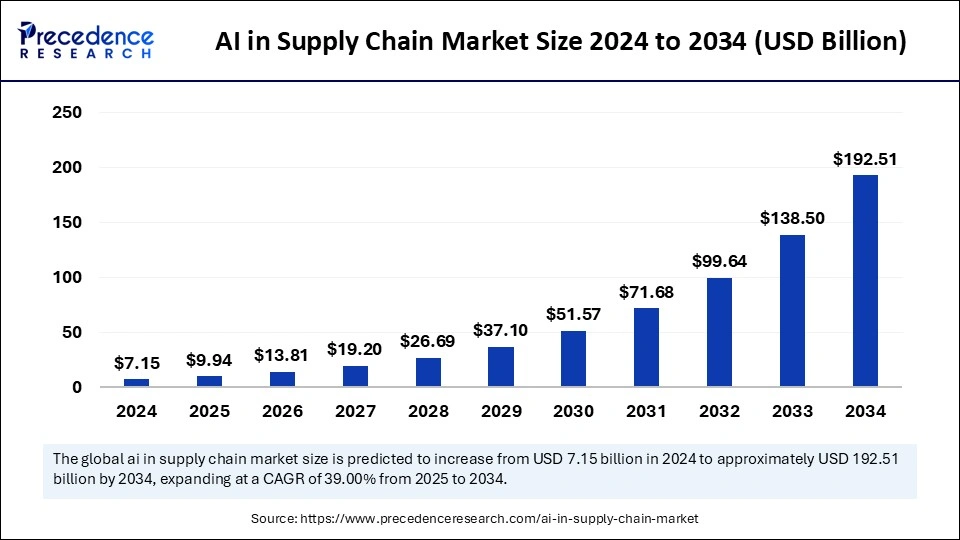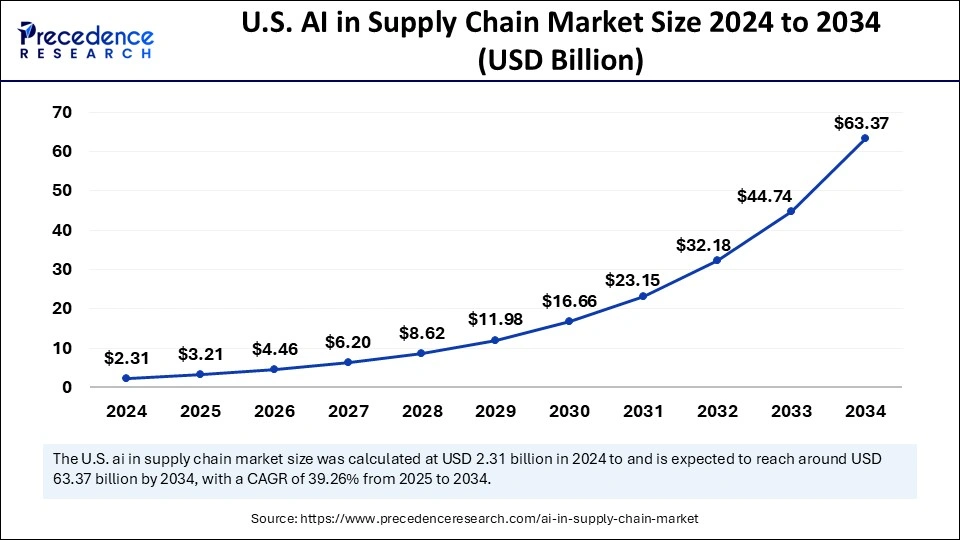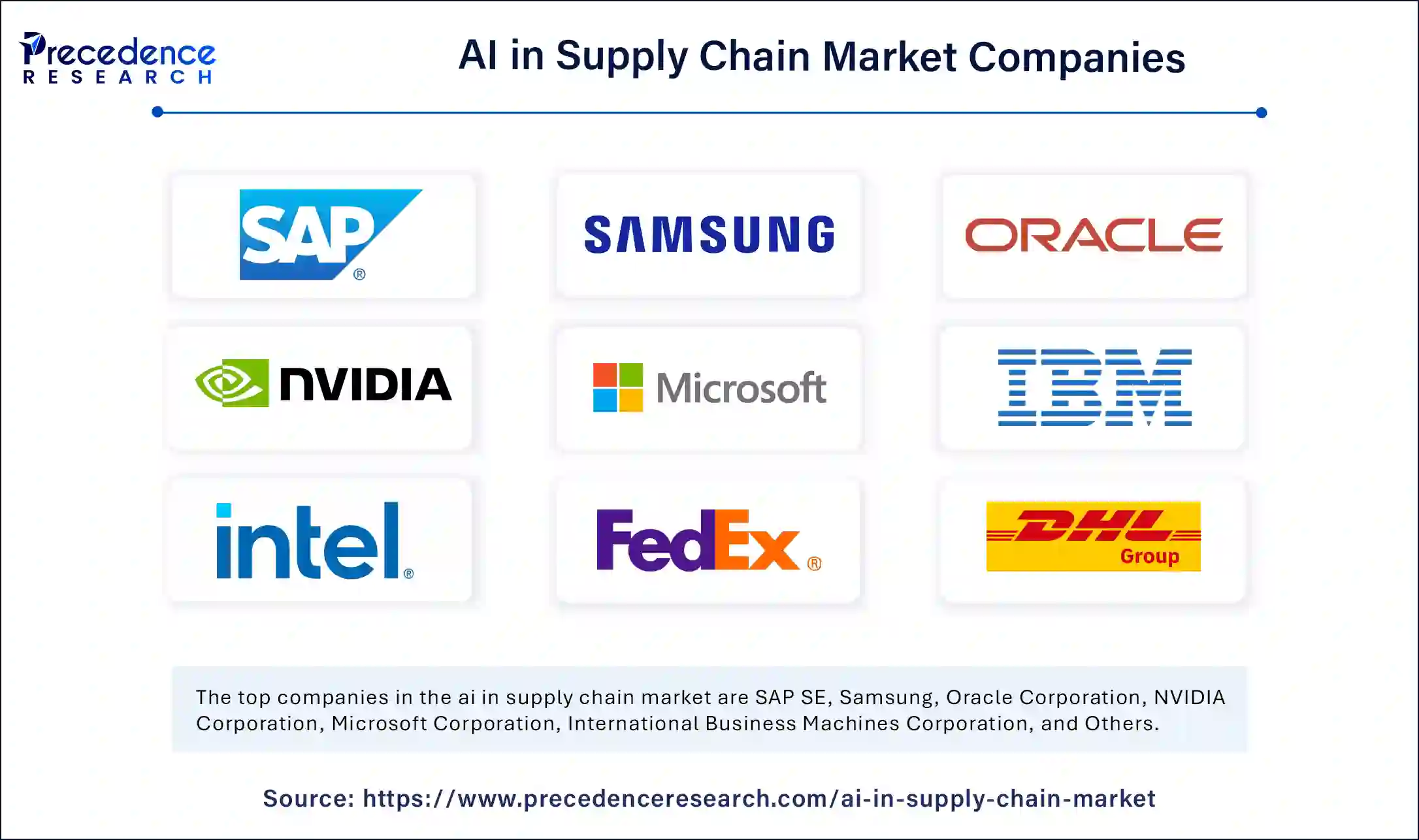July 2024
The global AI in supply chain market size is calculated at USD 9.94 billion in 2025 and is forecasted to reach around USD 192.51 billion by 2034, accelerating at a CAGR of 39.00% from 2025 to 2034. The North America market size surpassed USD 2.72 billion in 2024 and is expanding at a CAGR of 39.16% during the forecast period. The market sizing and forecasts are revenue-based (USD Million/Billion), with 2024 as the base year.
The global AI in supply chain market size accounted for USD 7.15 billion in 2024 and is predicted to increase from USD 9.94 billion in 2025 to approximately USD 192.51 billion by 2034, expanding at a CAGR of 39.00% from 2025 to 2034. The market growth is attributed to the increasing adoption of AI-driven automation and real-time monitoring solutions to enhance supply chain efficiency and resilience.

The U.S. AI in supply chain market size was exhibited at USD 2.31 billion in 2024 and is projected to be worth around USD 63.37 billion by 2034, growing at a CAGR of 39.26% from 2025 to 2034.

North America led the AI in supply chain market by capturing the largest share in 2024. This is mainly due to the widespread acceptance of AI-driven logistics solutions and automation technologies. The region is home to some of the leading technology companies, driving innovations in AI solutions. The robust retail networks and well-established logistic sector further bolstered the market in the region. The region is an early adopter of AI technologies due to its strong focus on improving operational efficiency and better resource distribution. Supply chain resilience received support from AI implementation in predictive analytics and demand forecasting alongside warehouse automation during ongoing global disturbances. The rapid surge in e-commerce activities boosted the adoption of artificial intelligence for managing inventory and optimizing supply chains.
Asia Pacific is anticipated to witness the fastest growth during the forecast period, owing to the rising focus on industrial automation and digital revolution, boosting the need for AI solutions. With the rising import-export activities, there is a high need to optimize supply chain operations. The manufacturing sector received substantial investments from China, Japan, and India to improve production efficiency and minimize operational costs. The rapid expansion of the e-commerce industry and the increasing need for effective delivery solutions boost the adoption of AI solutions in distribution and transportation networks. Smart logistics is gaining immense popularity as a result of government initiatives to promote advanced technologies. Moreover, rising government initiatives to promote the use of AI technologies in every sector are likely to support the growth of the AI in supply chain market in the region.

Europe is observed to grow at a considerable growth rate in the upcoming period. This is mainly due to its supportive regulatory frameworks, which promote digitalization throughout logistics and manufacturing. Major automotive companies within Germany, France, and the UK used AI technologies in supply chain planning and inventory management. With the growing focus on warehouse automation and supply chain optimization, the adoption of AI-powered robots has increased in the region. Furthermore, the labor shortage is a key factor encouraging European manufacturing and logistics companies to shift toward AI solutions, which is expected to the market growth.
Organizations use artificial intelligence technologies to increase supply chain complexity and achieve efficiency gains with increased resilience. Suppliers are increasingly using AI technologies to automate and streamline supply chain operations. AI’s predictive maintenance capabilities help businesses and manufacturers forecast future demands, manage inventory levels, and streamline logistic processes. Businesses are rapidly embracing AI technologies to reduce the impact of disruptions while strengthening their supply chains. Furthermore, the e-commerce growth alongside customer requirements for live tracking services has led to increased investments in AI-based inventory management and logistics solutions.
| Report Coverage | Details |
| Market Size by 2034 | USD 192.51 Billion |
| Market Size in 2025 | USD 9.94 Billion |
| Market Size in 2024 | USD 7.15 Billion |
| Market Growth Rate from 2025 to 2034 | CAGR of 39.00% |
| Dominated Region | North America |
| Fastest Growing Market | Asia Pacific |
| Base Year | 2024 |
| Forecast Period | 2025 to 2034 |
| Segments Covered | Offering, Technology, Application, End-Use, and Regions |
| Regions Covered | North America, Europe, Asia-Pacific, Latin America and Middle East & Africa |
Increasing Focus on Supply Chain Optimization
The rising focus on supply chain optimization is anticipated to drive the growth of the AI in supply chain market. Through predictive analytics, businesses predict market changes, which helps them minimize surplus stock and avoid product shortages. The use of AI-driven automation systems enables faster distribution times that help in timely deliveries and economic operations. AI can analyze historical data in supply chains and identify potential disruptions and bottlenecks, enabling businesses to take proactive measures to mitigate risks, enhance operations, and manage resources better. According to a Gartner survey conducted in 2024, leading supply chain organizations are investing in AI and machine learning to optimize processes. The survey confirmed that leading organizations lead their peers in both process automation and optimization through Artificial Intelligence/Machine Learning because these organizations actively invest in digital strategies to boost productivity. Furthermore, various companies are launching innovative AI-driven tools and software, which further support market growth.
High Implementation Costs
The high costs associated with AI integration are anticipated to limit the adoption across small and medium-sized enterprises (SMEs). The execution of advanced AI-driven systems requires substantial investments in software and hardware. AI-driven systems require regular maintenance to ensure proper functioning. This increases operational costs, creating barriers for organizations with minimal monetary resources. Businesses often hesitate to adopt AI technologies in traditional supply chain approaches, as AI technologies require expertise, delaying AI implementation and adoption.
Surging Adoption of Autonomous Supply Chain Solutions
The rising adoption of autonomous supply chain solutions creates immense opportunities in the AI in supply chain market. With the growing focus on supply chain automation, the implementation of robotics is rising in logistics and warehousing. AI-powered robotic systems run order-picking operations, packing activities, and sorting items, decreasing human workforce needs. Autonomous vehicles and drones enable delivery services for the last mile while increasing the operation speed and efficiency throughout distribution systems. AI-driven robots enable employees to redirect their focus from basic repetitive tasks to core activities. Organizations use intelligent automation systems to speed up delivery times, as customers expect quicker package delivery services. Amazon envisioned a 25% cut in delivery expenses and times by applying state-of-the-art robots and AI systems.
The software segment dominated the AI in supply chain market with the largest share in 2024 as businesses required advanced analytics and predictive modeling with real-time decision-making tools. Businesses use AI software solutions to maximize their supply chain operations, boost organizational effectiveness, and lower operational expenses. Moreover, software solutions are easily adaptable to current systems and provide personalized solutions, further fueling the segment growth.
The services segment is expected to grow at the fastest rate in the near future. AI technologies require regular maintenance for their optimal function, boosting the demand for maintenance services. Businesses demand advanced and affordable AI technologies to enhance their manufacturing, distribution, and supply chain operations, which further support segmental growth. Moreover, the rising demand for AI as a service (AIaaS) is expected to boost the segment’s growth. AIaaS enables businesses to experiment with AI without large investments and low risks.
The machine learning segment held a considerable share of the AI in supply chain market in 2024. This is mainly due to its increased adoption in demand forecasting, inventory management, and predictive maintenance. Machine learning algorithms analyze large datasets, enabling businesses to identify trends and make informed decisions. This, in turn, improves operational efficiency while lowering costs. Moreover, the machine learning models help in warehouse automation and supply chain optimization.
The computer vision segment is anticipated to grow at a significant rate during the studied years. The segment growth is attributed to the rising demand for advanced AI systems for supply chain optimization. The adoption of computer vision technology enables businesses to enhance visibility across the entire process, from manufacturing to distribution. Moreover, it allows businesses to manage inventory levels and enhance transparency in supply chains.
The supply chain planning segment dominated the AI in supply chain market in 2024 due to the rise in the need for supply chain optimization. Businesses often seek advanced capabilities to forecast demand accurately while optimizing inventory management and improving production schedules. AI technologies help organizations handle their intricate global supply chain structures by lowering operational expenditures while providing quick market adaptation capabilities. Machine learning models produced more precise predictions with data-based decision systems, thus improving operational efficiency and customer experience.
The growth of e-commerce further boosted the need for advanced supply chain planning solutions that enable the efficient management of complex supply chain structures. According to the report published in MDPI journal, supply chain operations that implement AI achieve 15% lower logistics expenses with decreased inventory amounts by 35%.
The warehouse management segment is projected to grow rapidly in the coming years, owing to the escalating robot and automated technology deployment, which streamlines warehouse operations and reduces labor expenses. Real-time inventory tracking and optimized storage arrangement with improved fulfillment operations result from AI-driven warehouse management solutions. Inventory management accuracy is enhanced through the combination of computer vision and Internet of Things enabled technologies, which strengthen quality control systems. The necessity for fast delivery fulfillment has escalated, so companies are seeking intelligent warehouse management solutions.
The automotive segment held the largest share of the AI in supply chain market in 2024 due to the rising demand for electric and autonomous vehicles across the globe, creating complexities in supply chain operations. The automotive sector requires intelligent solutions to manage vast supplier networks and speed up the delivery of specific components. Stringent regulations regarding safety and vehicle performance standards can be achieved through AI-powered quality control systems utilized in vehicle manufacturing. As per the DATAFOREST product & data engineering company 2024 report, the implementation of AI technology in automotive manufacturing helps businesses cut their production delays by 20%, thus simplifying their operations while decreasing their expenses.
The retail segment is likely to expand rapidly in the coming years due to the rapid expansion of retail networks. Retail stores require AI systems to process sales data and identify customer patterns, which help them achieve better demand estimates and improved inventory control. Such methods help decrease stock shortages and diminish inventory excess, thus improving both customer satisfaction and operational performance. AI enables retail stores to predict future demands and optimize supply chains by managing inventory levels.

By Offering
By Technology
By Application
By End-Use
By Region
For inquiries regarding discounts, bulk purchases, or customization requests, please contact us at sales@precedenceresearch.com
No cookie-cutter, only authentic analysis – take the 1st step to become a Precedence Research client
July 2024
October 2024
February 2025
July 2024